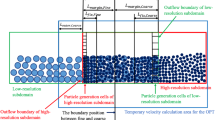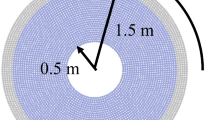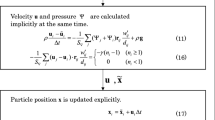Abstract
In recent years, particle methods, which are good for moving boundary problems, have become an effective approach to understand and predict flows in complex geometry, such as lubrication behaviors in rolling bearings. This study adopted a physically consistent particle method, i.e., the moving particle hydrodynamics for incompressible flows (MPH-I) method. For capturing the free surface flows in lubrication, a surface tension model was included. In order to maintain the physical consistency in the MPH-I method, the surface tension model expressed with the two density potentials, which are cohesive pressure potential (CPP) and density gradient potential (DGP), was adopted. The MPH-I method with the two-potential-based surface tension model enabled to handle negative pressure and nearly incompressible flow with very large bulk modulus. In fact, the MPH-I method could successfully reproduce fundamental pressure generation effects in the fluid film lubrication, i.e., the wedge film and squeeze film effects. Furthermore, the computed lubrication pressure agreed well with the experimental results and the classic prediction with Reynolds equation. This implies that the present numerical method was validated under the fluid film lubrication problems.












Similar content being viewed by others
References
Lucy LB (1977) A numerical approach to the testing of the fission hypothesis. Astron J 82:1013–1024. https://doi.org/10.1086/112164
Gingold RA, Monaghan JJ (1977) Smoothed particle hydrodynamics: theory and application to non-spherical stars. Mon Not R Astron Soc 181(3):375–389. https://doi.org/10.1093/mnras/181.3.375
Koshizuka S, Oka Y (1996) Moving particle semi-implicit method for fragmentation of incompressible fluid. Nucl Sci Eng 123(3):421–434. https://doi.org/10.13182/NSE96-A24205
Koshizuka S (2011) Current achievements and future perspectives on particle simulation technologies for fluid dynamics and heat transfer. J Nucl Sci Technol 48(2):155–168. https://doi.org/10.1080/18811248.2011.9711690
Gotoh H, Khayyer A (2016) Current achievements and future perspectives for projection-based particle methods with applications in ocean engineering. J Ocean Eng Mar Energy 2:251–278. https://doi.org/10.1007/s40722-016-0049-3
Violeau D, Rogers BD (2016) Smoothed particle hydrodynamics (SPH) for free-surface flows: past, present and future. J Hydraul Res 54(1):1–26. https://doi.org/10.1080/00221686.2015.1119209
Koshizuka S, Shibata K, Kondo M, Matsunaga T (2018) Moving particle semi-implicit method: a meshfree particle method for fluid dynamics. Academic Press
Ye T, Pan D, Huang C, Liu M (2019) Smoothed particle hydrodynamics (SPH) for complex fluid flows: recent developments in methodology and applications. Phys Fluid 31:011301. https://doi.org/10.1063/1.5068697
Li G, Gao J, Wen P, Zhao Q, Wang J, Yan J, Yamaji A (2020) A review on MPS method developments and applications in nuclear engineering. Comput Methods Appl Mech Eng 367:113166. https://doi.org/10.1016/j.cma.2020.113166
Ji Z, Stanic M, Hartono EA, Chernoray V (2018) Numerical simulations of oil flow inside a gearbox by smoothed particle hydrodynamics (SPH) method. Tribol Int 127:47–58. https://doi.org/10.1016/j.triboint.2018.05.034
Muto K, Sakai I, Ozaki N (2010) Calculation of stirring resistance of fluid using particle method. Trans Soc Autom Eng Jpn 41(1):147–151. https://doi.org/10.11351/jsaeronbun.41.147
Yuhashi N, Matsuda I, Koshizuka S (2016) Calculation and validation of stirring resistance in cam-shaft rotation using the moving particle semi-implicit method. J Fluid Sci Technol 11(3):JFST0018. https://doi.org/10.1299/jfst.2016jfst0018
Yuhashi N, Koshizuka S (2020) Calculation of oil churning in crankcase of reciprocating pump (calculation of free surface flow by moving particle semi-implicit method). Trans JSME 86(881):1900343. https://doi.org/10.1299/transjsme.19-00343
Kyle JP, Terrell EJ (2013) Application of smoothed particle hydrodynamics to full-film lubrication. ASME J Tribol 135(4):041705. https://doi.org/10.1115/1.4024708
Tanaka K, Fujino T, Fillot N, Vergne P, Iwamoto K (2019) Numerical simulation of hydrodynamic lubrication by SPH method. Abstract Book of 46th Leeds-Lyon Symposium on Tribology 21
Brackbill JU, Kothe DB, Zemach C (1992) A continuum method for modeling surface tension. J Comput Phys 100(2):335–354. https://doi.org/10.1016/0021-9991(92)90240-Y
Khayyer A, Gotoh H, Shimizu Y (2017) Comparative study on accuracy and conservation properties of two particle regularization schemes and proposal of an optimized particle shifting scheme in ISPH context. J Comput Phys 332:236–256. https://doi.org/10.1016/j.jcp.2016.12.005
Paggi M, Amicarelli A, Lenarda P (2021) SPH modelling of hydrodynamic lubrication: laminar fluid flow-structure interaction with no-slip conditions for slider bearings. Comput Part Mech 8:665–679. https://doi.org/10.1007/s40571-020-00362-1
Negishi H, Fujihara H, Takahashi H, Shibata K, Maniwa K, Obara S (2020) Numerical analysis of fluid lubrication in line contact by using the MPS method. Trans JSME 86(890):2000241. https://doi.org/10.1299/transjsme.20-00241
Yamada D, Imatani T, Shibata K, Maniwa K, Obara S, Negishi H (2022) Application of improved multiresolution technique for the MPS method to fluid lubrication. Comput Part Mech 9:421–441. https://doi.org/10.1007/s40571-021-00420-2
Shibata K, Koshizuka S, Matsunaga T, Masaie I (2017) The overlapping particle technique for multi-resolution simulation of particle methods. Comput Methods Appl Mech Eng 325:434–462. https://doi.org/10.1016/j.cma.2017.06.030
Dowson D, Taylor CM (1979) Cavitation in bearings. Annu Rev Fluid Mech 11:35–65. https://doi.org/10.1146/annurev.fl.11.010179.000343
Swegle JW, Hicks DL, Attaway SW (1995) Smoothed particle hydrodynamics stability analysis. J Comput Phys 116(1):123–134. https://doi.org/10.1006/jcph.1995.1010
Monaghan JJ (2000) SPH without a tensile instability. J Comput Phys 159(2):290–311. https://doi.org/10.1006/jcph.2000.6439
Dyka CT, Randles PW, Ingel RP (1997) Stress points for tension instability in SPH. Int J Numer Meth Eng 40(13):2325–2341. https://doi.org/10.1002/(SICI)1097-0207(19970715)40:13%3c2325::AID-NME161%3e3.0.CO;2-8
Belytschko T, Xiao S (2002) Stability analysis of particle methods with corrected derivatives. Comput Math Appl 43:329–350. https://doi.org/10.1016/S0898-1221(01)00290-5
Hicks DL, Liebrock LM (2004) Conservative smoothing with B-splines stabilizes SPH material dynamics in both tension and compression. Appl Math Comput 150(1):213–234. https://doi.org/10.1016/S0096-3003(03)00222-4
Dilts GA (1999) Moving-least-squares-particle hydrodynamics: consistency and stability. Int J Numer Methods Eng 44(8):1115–1155. https://doi.org/10.1002/(SICI)1097-0207(19990320)44:8%3c1115::AID-NME547%3e3.0.CO;2-L
Xu R, Stansby P, Laurence D (2009) Accuracy and stability in incompressible SPH (ISPH) based on the projection method and a new approach. J Comput Phys 228(18):6703–6725. https://doi.org/10.1016/j.jcp.2009.05.032
Koshizuka S, Nobe A, Oka Y (1998) Numerical analysis of breaking waves using the moving particle semi-implicit method. Int J Numer Methods Fluids 26(7):751–769. https://doi.org/10.1002/(SICI)1097-0363(19980415)26:7%3c751::AID-FLD671%3e3.0.CO;2-C
Khayyer A, Gotoh H (2008) Development of CMPS method for accurate water-surface tracking in breaking waves. Coast Eng J 50(2):179–207. https://doi.org/10.1142/S0578563408001788
Khayyer A, Gotoh H (2011) Enhancement of stability and accuracy of the moving particle semi-implicit method. J Comput Phys 230(8):3093–3118. https://doi.org/10.1016/j.jcp.2011.01.009
Tsuruta N, Khayyer A, Gotoh H (2013) A short note on dynamic stabilization of moving-particle semi-implicit method. Comput Fluids 82:158–164. https://doi.org/10.1016/j.compfluid.2013.05.001
Lee BH, Park JC, Kim MH, Hwang SC (2011) Step-by-step improvement of MPS method in simulating violent free-surface motions and impact-loads. Comput Methods Appl Mech Eng 200:1113–1125. https://doi.org/10.1016/j.cma.2010.12.001
Matsunaga T, Koshizuka S (2022) Stabilized LSMPS method for complex free-surface flow simulation. Comput Methods Appl Mech Eng 389:114416. https://doi.org/10.1016/j.cma.2021.114416
Kondo M (2021) A physically consistent particle method for incompressible fluid flow calculation. Comput Part Mech 8:69–86. https://doi.org/10.1007/s40571-020-00313-w
Kondo M, Fujiwara T, Masaie I, Matsumoto J (2022) A physically consistent particle method for high-viscous free-surface flow calculation. Comput Part Mech 9:265–276. https://doi.org/10.1007/s40571-021-00408-y
Kondo M, Matsumoto J (2021) Weakly compressible particle method with physical consistency for spatially discretized system. Trans JSCES 2021:20210006. https://doi.org/10.11421/jsces.2021.20210006
Kondo M, Matsumoto J (2021) Pressure substituting implicit solver to speed-up moving particle hydrodynamics method for high-viscous incompressible flows. Trans JSCES 2021:20210016. https://doi.org/10.11421/jsces.2021.20210016
Kondo M, Matsumoto J (2021) Surface tension and wettability calculation using density gradient potential in a physically consistent particle method. Comput Methods Appl Mech Eng 385:114072. https://doi.org/10.1016/j.cma.2021.114072
Floberg L (1965) On hydrodynamic lubrication with special reference to sub-cavity pressures and number of streamers in cavitation regions. Acta Poly Scand Mech Eng Ser 19:3–35
Bruyere V, Fillot N, Morales-Espejel GE, Vergne P (2012) A two-phase flow approach for the outlet of lubricated line contacts. ASME J Tribol 134(4):041503
Hamrock BJ, Schmid SR, Jacobson BO (2004) Fundamentals of fluid film lubrication, 2nd edn. CRC Press
Hori Y (2016) Hydrodynamic lubrication. Springer
Kuroda S, Hori Y (1978) An experimental study on cavitation and tensile stress in a squeeze film. Lubrication 23:436–442 (in Japanese)
Goldstein H, Safko JL, Poole CP (2013) Classical mechanics. Pearson New International Edition
Monaghan JJ (1992) Smoothed particle hydrodynamics. Ann Rev Astron Astrophys 30:543–574. https://doi.org/10.1146/annurev.aa.30.090192.002551
Hu XY, Adams NA (2006) Angular-momentum conservative smoothed particle dynamics for incompressible viscous flows. Phys Fluids 18:101702. https://doi.org/10.1063/1.2359741
Nishida A (2010) Experience in developing an open source scalable software infrastructure in Japan. Computer science and its applications-ICCSA 2010, Lecture Notes in Computer Science, Springer, pp. 448–462
Gray CG, Gubbins KE (1984) Theory of molecular fluids: fundamentals. Oxford University Press
Acknowledgements
This work is supported by the Japan Society for the Promotion of Science (JSPS) KAKENHI Grant No. 21K03847. All the simulations in this study were performed on the JAXA Supercomputer System Generation 3 (JSS3). The authors would like to express their sincere appreciation for their support.
Author information
Authors and Affiliations
Corresponding author
Ethics declarations
Conflict of interest
On behalf of all authors, the corresponding author states that there is no conflict of interest.
Additional information
Publisher's Note
Springer Nature remains neutral with regard to jurisdictional claims in published maps and institutional affiliations.
Rights and permissions
Springer Nature or its licensor (e.g. a society or other partner) holds exclusive rights to this article under a publishing agreement with the author(s) or other rightsholder(s); author self-archiving of the accepted manuscript version of this article is solely governed by the terms of such publishing agreement and applicable law.
About this article
Cite this article
Negishi, H., Kondo, M., Amakawa, H. et al. A fluid lubrication analysis including negative pressure using a physically consistent particle method. Comp. Part. Mech. 10, 1717–1731 (2023). https://doi.org/10.1007/s40571-023-00584-z
Received:
Revised:
Accepted:
Published:
Issue Date:
DOI: https://doi.org/10.1007/s40571-023-00584-z




